HPE has a new server built around the Ampere Altra/ Altra Max. The HPE ProLiant RL300 is the company’s most recent foray into the Arm server market. HPE was actually a leader in the Arm server market at one point and is now looking to get back in with a modest server.
HPE ProLiant RL300 Gen11 Launched
The new HPE ProLiant RL300 Gen11 is an Ampere Altra / Altra Max-based server although it does not focus on that fact in its main overview slide. Instead, it focuses on the fact that it can scale to 128 cores.
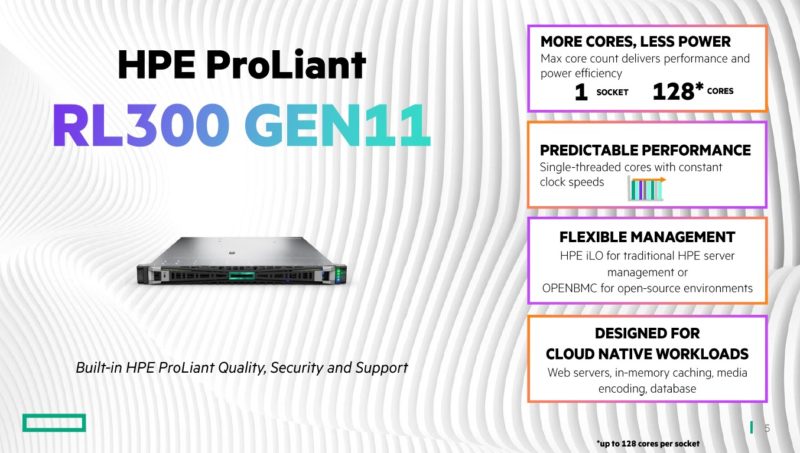
From a form factor perspective, the new ProLiant RL300 is a 1U server. It also takes branding from the HPE ProLiant 11th generation.

Here is the front, and it appears as though HPE is highlighting its 10x 2.5″ implementation, but this is not an E.3 EDSFF implementation. We were hoping on a forward-looking Arm server HPE would focus its efforts on emerging technology trends. Instead, it is being pictured with low capacity 960GB 2.5″ SAS SSDs, a decidedly dated storage solution. Again, we are hoping that this is just what HPE picked for the renders.

At the rear of the system we see the management iLO port, two USB 3, serial, and VGA ports. There is also a redundant power supply option. While there are no onboard NICs, there are two risers that appear ready for full-height cards. There are also two OCP NIC 3.0 slots.

Zooming into the CPU, we can see that we get a full 8-channel memory and two DIMMs per channel. This is the full set for Ampere’s current generation parts.
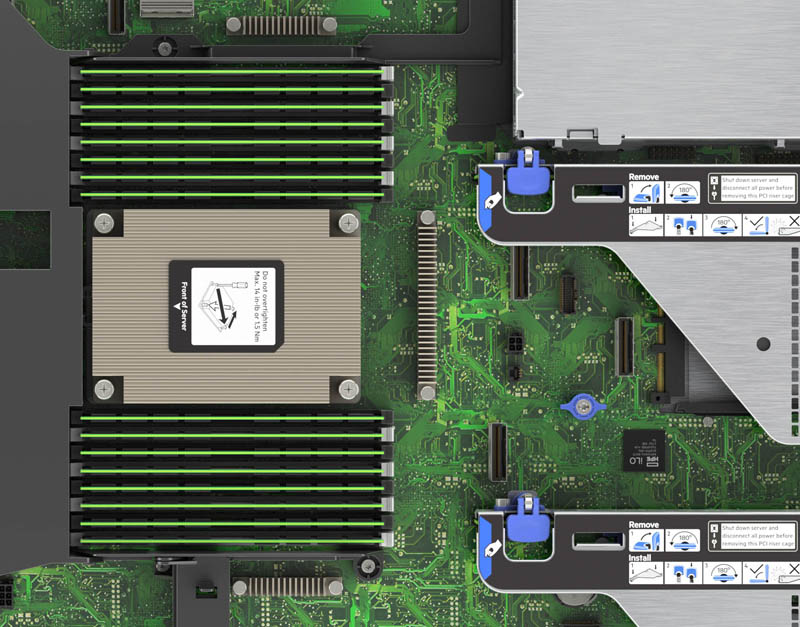
On the right side, we can see the iLO chip displayed while most of the motherboard is being shown without other components. Just above that iLO chip is the OCP NIC 3.0 connector.
Something else that seemed notable is that the server has what appears to be an Internal M.2 boot option. This is the assembly at the top of the below photo.
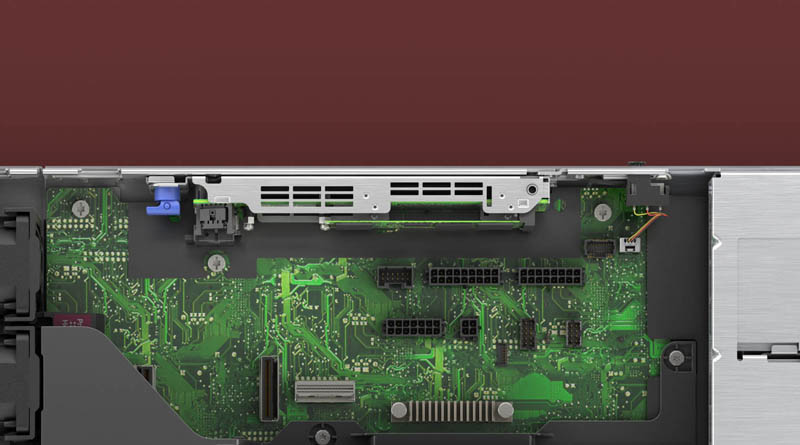
Of course, this is a single socket server while other vendors have been out with dual socket Ampere servers for some time. Still, it is important that HPE is getting into the market.
Final Words
Taking a step back for context. HPE was a leader in the Arm server space when it pioneered things like Arm sleds in the HPE Moonshot (see our reference thread here.) The reason then was that certain companies (e.g. Zynga) needed lower performance and low-cost cores. Those same forces are driving the Ampere Altra (up to 80 cores) and Altra Max (up to 128 cores) today.
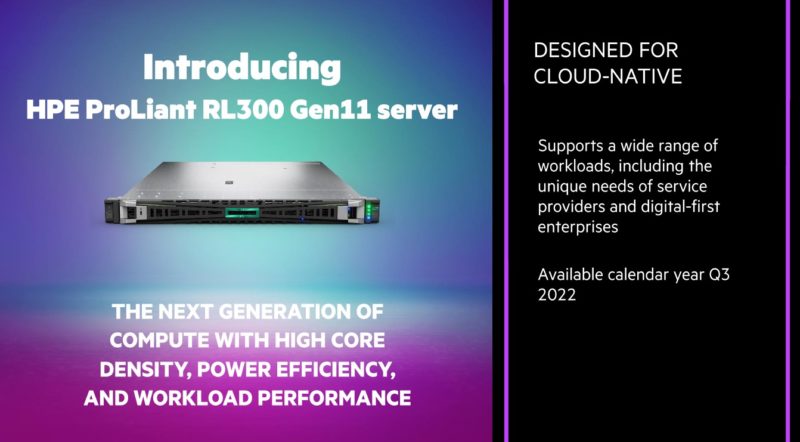
HPE’s design is available in Q3, which is relatively soon. It is also late in the Altra and Altra Max product cycles, especially for a Gen11 system. HPE will likely have Gen11 with PCIe Gen5 but then have the RL300 as a Gen11 system with older generation features. Our sense is that this type of server is what we would expect customers who are building out installations similar to a lot of the dedicated server farms would use. In those markets, we typically see single-socket 1U servers. These are not the big virtualization platforms we would typically see as dual-socket servers.
Still, HPE re-entering the Arm server market is a big deal for the industry. It is signaling that it takes the private cloud seriously and is trying to offer an alternative to AWS Graviton and Arm offerings (using Ampere) from Microsoft, Oracle, and others.

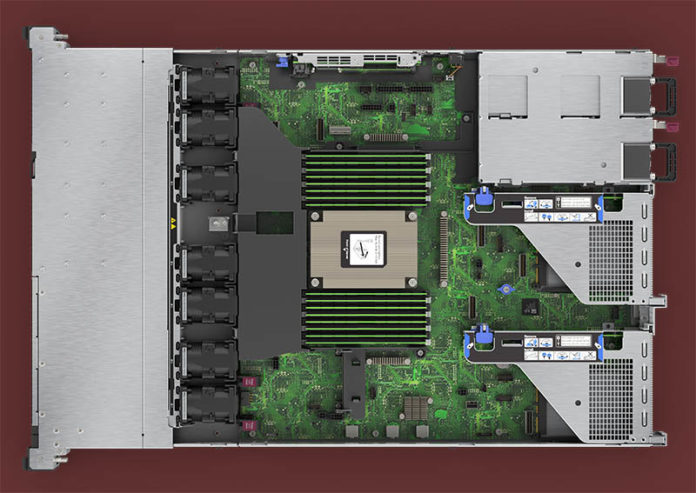



Seeing single socket is very interesting. Given that targeting ARM servers still requires a bit more customization than x86 I would have assumed that customers with workloads large enough to cover that investment would be the target audience and that such customers would, by virtue of having sufficiently large workloads, substantially prefer dual socket.
Anyone know if there’s some sort of edge/branch application for which ARM is now well supported enough that it’s no longer all that adventurous; or if people targeting these high core count CPUs aren’t terribly concerned about how many of them are tightly coupled and sharing the same memory space vs. relatively loosely coupled at the network level?
Would love to see some of these running relatively slow high capacity storage as a Backup Target – particularly as object storage
It will also support OpenBMC: https://www.hpe.com/us/en/compute/openbmc-proliant-servers.html
Is that Dsub15 “VGA” port for use with a server-room crash cart?
Is that still a thing (vs. iLO port)?
I worked in a data center from 2012 – 2021: Crash carts were still used…I used to wonder if modest-sized monitors with VGA were still going to be available.
Most of the server interactions were remote via BMC, but sometimes a crash cart was the best/only option.
Once a vendor sent hundreds of servers with the wrong boot order for our imaging system. I had to reboot each server, with a crash cart connected, power-cycle the server and wait for the BIOS options screen to appear.
At least Ampere Altra aren’t hiding in a self imposed specification darkroom like Marvell did with ThunderX2. They (Ampere) want market share and aren’t afraid to go get it. Marvell isn’t such a “risc” taker and cancelled ThunderX3. Also HPE isn’t taking a huge “risc” here, Lenovo has been a fab/distribution partner for Ampere for some time selling branded servers.
The wildcard here is Qualcomm Nuvia, their sales team keep making noises about their hot new CPU but it still hasn’t got past taping to fab. So what is the ARM world going to look like in a “post-neoverse” world?
Has anyone able to install VMware ESXi on HPE RL300 Gen11?